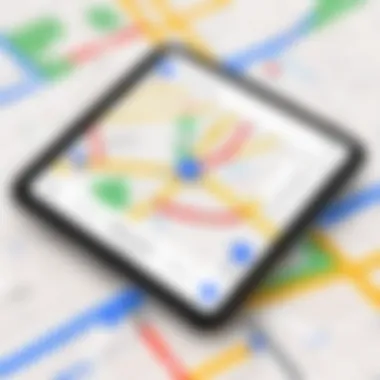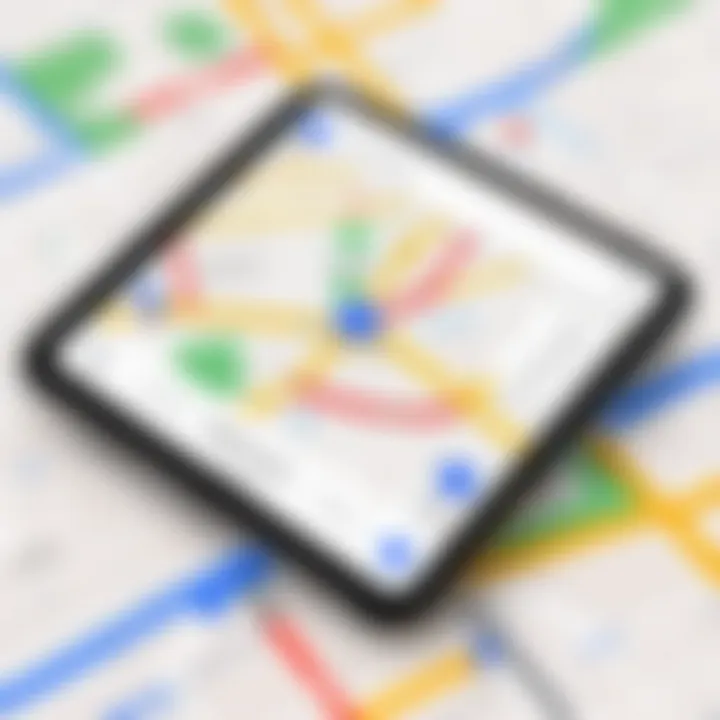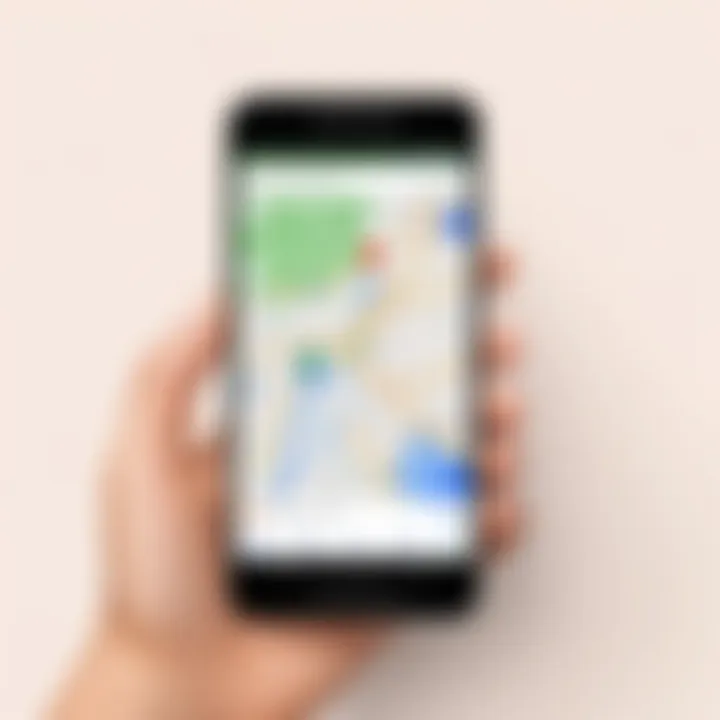Understanding Google GPS Apps: Features and Insights


Intro
Navigating the world has evolved dramatically with the advent of GPS technology. Google GPS applications are at the forefront of this transformation. These apps are not just tools for finding directions; they have become integral to daily life, influencing how we travel, explore, and interact with our environment.
This article will offer a detailed look into the technology behind Google GPS apps. We will explore their key specifications, unique features, and how they set themselves apart from alternatives in the navigation market. The rise of artificial intelligence in these applications is noteworthy. It offers personalized recommendations, enhances route planning, and generally makes navigation easier and more efficient.
Questions related to user privacy also arise with these advancements. While convenience is often the primary focus, the implications for data security and user anonymity warrant scrutiny. Understanding these aspects will empower users to make informed decisions about their navigation choices.
By analyzing both the advantages and challenges, readers will gain insight into how Google GPS applications have redefined modern navigation. Let's start with an overview of the technology involved.
Prolusion to Google GPS Apps
Understanding Google GPS applications is essential in today’s technology-driven world. As people increasingly rely on digital navigation, it is paramount to assess how these tools operate and their overall significance in our daily lives. Google’s GPS apps provide indispensable services that aid in real-time navigation, efficient route planning, and insights into traffic conditions. This section delves into the evolution of GPS technology and gives an overview of Google GPS applications, highlighting their features and benefits.
The Evolution of GPS Technology
Global Positioning System (GPS) technology has a fascinating history. Initially developed for military use in the 1970s, GPS was later made available for civilian use. Over time, GPS technology has evolved from simple location tracking to sophisticated applications that integrate with various devices, including smartphones and vehicles. The accuracy improved significantly, advancing from approximately 100 meters in the early days to a few centimeters for modern devices.
In the 1990s, when GPS technology was fully operational for civilian applications, it opened the door to a multitude of location-based services. The adoption of smartphones and the rise of mobile apps further catalyzed this evolution. Today, GPS technology is an essential component in many sectors, including transportation, logistics, and personal navigation, reshaping how individuals interact with their environments.
Overview of Google GPS Applications
Google has positioned itself at the forefront of GPS applications through powerful tools, most notably Google Maps and Waze. Google Maps offers comprehensive mapping services, allowing users to explore areas in intricate detail, whether by foot, vehicle, or public transit. Users can view real-time traffic conditions and get directions tailored to their mode of travel. Waze, on the other hand, provides crowd-sourced traffic information, emphasizing user interaction to share live updates.
These applications are not mere navigation aids; they are indispensable resources that have transformed the way people approach travel and exploration. Features of these applications extend beyond traditional mapping functions. They include options for searching for nearby businesses, viewing satellite imagery, and receiving alerts about potential hazards along routes.
Overall, Google GPS applications embody a convergence of technology and daily life, making them vital tools for navigating the complexities of urban and rural environments alike.
Key Features of Google GPS Apps
Google GPS applications have transformed transportation and navigation for individuals and businesses alike. Their significance extends beyond mere location finding; they are equipped with essential features that cater to a variety of user needs. Understanding these features is necessary for users to fully benefit from these applications. In this section, we will explore the key elements of Google GPS apps, focusing on their practical benefits and important considerations.
Real-Time Navigation
Real-time navigation is one of the standout features of Google GPS apps. This functionality enables users to receive up-to-date directions as they travel. The app continuously updates the route based on live traffic conditions, providing an effectiv way to reach a destination efficiently. For example, if a user is stuck in traffic, the app might suggest alternative routes to avoid delays. Such capabilities enhance travel experience and save time.
Additionally, real-time navigation supports various modes of transport, including driving, walking, and biking. This feature helps users adapt their travel choices according to activity and environment. Users can also view estimated arrival times, which helps them assess their travel plans better.
Traffic Updates and Route Optimization
Google GPS apps offer robust traffic updates that significantly optimize travel routes. Utilizing a vast network of data, the apps analyze traffic patterns and inform users of potential slowdowns or hazards. This has proven to be particularly valuable during peak hours, where drivers can experience substantial delays.
Moreover, the route optimization feature ensures that users not only take the shortest path but also the quickest one considering current traffic conditions. For instance, if a user’s usual route becomes congested, the app promptly identifies a faster alternative route. These updates are made possible through algorithms that assess real-time data from multiple sources, allowing users to make informed decisions on their travel routes.
Integration with Other Google Services
Integration with other Google services amplifies the functionality of Google GPS apps. Seamless connections to applications like Google Maps and Google Assistant create a comprehensive navigation ecosystem. Users can manage their journeys more effectively, from planning to real-time navigation.


For instance, Google Assistant can provide voice-guided navigation while users are driving, allowing for safer and hands-free operation. Additionally, Google Search integration helps users easily find nearby points of interest, such as restaurants or gas stations. This cohesive experience enhances usability and increases the practicality of navigation solutions.
"The integration of various Google platforms allows users a unified experience that simplifies navigation and exploration."
Furthermore, users can synchronize their personalized settings and history across devices. This feature allows them to retrieve saved locations or preferences, enhancing the overall user experience and making navigation as smooth as possible.
The Role of Artificial Intelligence in Google GPS Apps
Artificial intelligence is increasingly prominent in Google GPS applications. It enhances user experience, improves navigation reliability, and offers personalized features. The integration of AI allows for real-time data analysis, making the apps smarter and more efficient. Understanding the role of AI provides insight into the functional capabilities of these applications.
Machine Learning and Predictive Analysis
Machine learning is a critical component in the advancements of Google GPS apps. Through this technology, the application learns user patterns. It can analyze historical data to predict traffic conditions and travel times. For example, when a user frequently travels a certain route during rush hours, the app can anticipate delays and advise alternative paths.
Predictive analysis utilizes real-time data combined with machine learning outcomes. It refines algorithms to improve responsiveness over time. As the app accumulates more data, it can predict with higher accuracy. This results in a more seamless navigation experience. Users benefit from receiving timely alerts about unexpected traffic jams or road closures, optimizing their itinerary.
Voice Navigation and Accessibility Features
Voice navigation is another significant AI feature in Google GPS applications. It enables safe hands-free interaction, particularly vital for drivers. Users simply speak commands to alter routes or search for locations. This feature enhances user safety and engagement with the app while driving.
Moreover, accessibility features cater to users with different needs. For instance, options like speech-to-text and enhanced sound alerts support visually impaired individuals. Google GPS apps focus on creating inclusive navigational aids for all users. Enhancing accessibility through AI not only broadens the user base but also promotes social responsibility.
"AI technologies are not just tools; they shape how users interact with GPS services daily."
In summary, AI plays a vital role in improving the functionality of Google GPS apps. Machine learning sharpens predictive analysis and informs real-time updates. Voice navigation and accessibility further enhance user interaction, confirming AI's importance in modern navigation technology.
User Privacy Considerations
In today's digital landscape, privacy is a critical topic for many individuals, especially regarding GPS applications like those offered by Google. These apps rely heavily on location data, leading to various privacy concerns. When users engage with Google GPS apps, it is essential to understand how their data is collected and used. This section will explore the vital factors surrounding user privacy, emphasizing the implications and benefits associated with the use of these applications.
Data Collection Practices
Google GPS apps, such as Google Maps, employ data collection techniques to enhance user experience and offer precise navigation. This process often includes gathering real-time data about users’ locations, search queries, travel patterns, and preferences.
The primary methods of data collection include:
- Location tracking: GPS technology allows Google to ascertain users' current locations continuously. This data helps in providing tailored navigation and accurate traffic updates.
- User-generated data: Many of these apps enable users to contribute information, like traffic conditions or point-of-interest reviews. These contributions can enrich the app's database but also raise questions about users' privacy.
- Analytics: Google can analyze user behavior within the app to improve services. However, this analysis often relies on substantial amounts of personal data.
While this data collection aims to improve user experience, it poses risks, such as unauthorized access or misuse of location information. Understanding these practices is crucial as users must balance convenience with their desire for privacy.
User Control Over Location Data
User empowerment is a significant aspect of privacy in GPS applications. Google provides various settings allowing users to manage their location data actively. This control enables users to define their comfort level with data sharing. Important features include:
- Location history: Users can access their location history via Google Maps. They can view past travels, but also have the option to delete this data, providing an avenue for greater privacy.
- Location sharing: Google allows users to share their live location with others temporarily. This feature, while useful for coordinating meet-ups, also requires careful consideration of who receives access.
- Settings customization: The apps offer options to switch off location access or even limit it to specific situations, such as while using the app. This flexibility is key for users wanting a tailored experience without compromising their privacy.
"Understanding and managing location data plays a foundational role in ensuring privacy while using Google GPS apps."


In summary, while Google GPS applications have transformed navigation, they raise important questions about user privacy that require attention. When users engage with these apps, they must be well-informed about data collection practices and the controls at their disposal. Ultimately, achieving a balance between a personalized navigation experience and privacy is essential for users today.
Advantages of Using Google GPS Apps
In the modern context, Google GPS apps have become essential tools for many individuals. Understanding their advantages can help users make informed choices about their navigation needs. The significance of ease of use, comprehensive mapping, and other features cannot be overstated, as they influence the efficiency of navigation tasks. Users can appreciate how these applications enhance daily commutes and travel experiences.
Ease of Use and Interface Design
One of the hallmarks of Google GPS apps is their user-friendly interface. When a person opens the app, they are greeted with an intuitive layout that simplifies navigation tasks. The design prioritizes essential functions, making it easy for users to find their desired features quickly. Operating the app requires minimal interaction, allowing users to focus on their surroundings rather than fiddling with menus.
The use of recognizable icons helps bridge the gap between functionality and user comprehension. Map displays are vibrant and clear, which enhances visibility even in less-than-ideal light conditions. Users can easily zoom in or out on maps to see details that matter. Instant access to options like getting directions, finding nearby restaurants, or checking traffic is presented with just a few taps.
This streamlined design reduces the learning curve associated with many competing apps. New users often find themselves proficient after only minimal exposure. Having a simple interface encourages more frequent use.
Comprehensive Mapping and Points of Interest
Another critical advantage of Google GPS apps is their extensive mapping capabilities. With a global reach, Google Maps covers vast geographic areas, offering detailed information about streets, neighborhoods, and more. The app doesn't just show routes but also incorporates essential points of interest. This includes places like hospitals, gas stations, restaurants, and landmarks, giving users better context about their surroundings.
Furthermore, the capability of Google GPS apps extends beyond simple mapping functionalities. They continuously update their databases, which helps keep information accurate. For instance, if a new restaurant opens or a road is closed for construction, the app reflects these changes almost immediately.
"The power of Google GPS apps lies in their ability to integrate comprehensive maps with real-time updates, ensuring that users always have the latest information at hand."
The provision of such detailed data assists users in making well-informed choices. For example, users can check reviews and ratings for nearby dining options before making a decision. Better access to location-specific information not only aids navigation but also elevates the overall user experience.
Limitations and Challenges
Understanding the limitations and challenges of Google GPS apps is crucial for users who rely on them for navigation. These limitations can affect the overall user experience and impact decision-making while on the road. By examining these factors, users can make more informed choices regarding their navigation tools and set realistic expectations.
Dependence on Internet Connectivity
One significant limitation of Google GPS applications is their dependence on internet connectivity. Most of these apps require continuous internet access to provide real-time navigation and updates. Without a stable connection, features such as live traffic updates, alternative route suggestions, and map data are compromised. In areas with weak cellular reception or no Wi-Fi, users may find themselves vulnerable to inaccurate or outdated information.
In addition to this, the need for internet access can also lead to unexpected inconveniences. If you are traveling through remote areas, it is possible to face a complete loss of navigation. In such scenarios, having a backup plan or alternative navigation method becomes essential. Users may consider downloading offline maps or using dedicated GPS devices for remote traveling.
Battery Consumption Issues
Another challenge users face is battery consumption. Google GPS apps can drain device batteries rapidly, especially when running in the background with location services active. The GPS functionality, coupled with data transmission, may lead to significant energy use. This can be problematic for users who need their devices for extended periods or do not have frequent access to charging options.
To combat this issue, it is advisable to be aware of battery-saving settings within the app. Utilizing features like low battery mode or reducing the frequency of location updates can help. Additionally, keeping the screen brightness at a moderate level and closing unused applications can extend battery life while using GPS.
"Being aware of these limitations can enhance your overall navigation experience and reduce potential frustration."
In summary, acknowledging the dependence on internet connectivity and battery consumption helps users navigate the limitations of Google GPS apps. Making informed decisions can lead to a better understanding of how to optimize the user experience in various scenarios.
Comparative Analysis of Google GPS Apps
A comparative analysis of Google GPS applications is essential as it reveals the strengths and weaknesses of these tools in relation to their competitors. This examination sheds light on various attributes such as user interface, reliability, and unique features that set them apart in a crowded market. Understanding how Google GPS apps compare with others can help users make informed decisions about which navigation application best suits their needs.


Comparison with Other Navigation Applications
When analyzing Google GPS apps, one must consider apps like Waze, Apple Maps, and HERE WeGo. Each application has its own approach to navigation and user experience. For example, Waze focuses heavily on community-driven traffic updates. It relies on real-time user input, which can sometimes provide more timely alerts about road hazards and traffic jams compared to Google Maps. On the other hand, Apple Maps integrates seamlessly with iOS devices, offering a smooth experience but sometimes lacking the extensive mapping data found in Google Maps.
Additionally, HERE WeGo stands out with its offline navigation capabilities. It downloads maps to a device, allowing users to navigate even without a robust internet connection. Therefore, when weighing options, users must consider factors like reliability under different conditions, ease of use, and the specific features that may cater to their individual needs.
User Experience Across Different Platforms
User experience is another critical element when comparing Google GPS apps. The performance of these applications can vary significantly across platforms such as Android and iOS. Google Maps offers a consistent experience on both systems, but some other apps might excel in one and perform mediocrely in another.
For Android users, the integration with the operating system can enhance functionality. Features like Google Assistant allow for hands-free navigation, which some apps may not support as well. In contrast, on iOS, users might find that Apple Maps provides a smoother experience and better integration with Siri.
"User experience varies notably with different operating systems, which can influence the overall effectiveness of navigation apps."
In summary, a comparative analysis helps users recognize the array of options available to them. By evaluating the features and user experiences of Google GPS apps against other navigation applications, tech-savvy individuals can select the best tool to enhance their navigation efficiency. Each application serves distinct needs and preferences, making this analysis not just useful, but necessary for optimizing navigation experiences.
Future Trends in GPS Technology
The landscape of GPS technology is continually evolving. As we look forward, it becomes crucial to understand how these changes impact navigation applications. Future trends indicate advancements that not only enhance usability but also improve accuracy. These developments can lead to more informed choices for consumers while navigating through urban environments and rural areas alike.
Advancements in Navigation Algorithms
Recent research has highlighted significant improvements in navigation algorithms. Such advancements often incorporate real-time data feeds, machine learning, and enhanced processing power. This results in more efficient routes that adjust in real-time based on user behavior.
- Dynamic Routing: Future algorithms will likely utilize cloud computing. By analyzing vast amounts of data, they can anticipate user needs. For example, if a driver regularly avoids toll roads, the system learns and adapts.
- Predictive Analysis: The use of historical data allows for anticipating traffic patterns. This feature can help users avoid congested routes even before they encounter delays.
Overall, these improvements lead to a smoother experience during navigation, supporting users in reaching their destinations more effectively.
The Impact of Autonomous Vehicles
The influence of autonomous vehicles on GPS technology is genuinely transformative. As self-driving cars become prevalent, the need for advanced GPS systems will increase. These systems must integrate with various sensors onboard to navigate safely without human intervention.
- Enhanced Accuracy: Autonomous vehicles require real-time positioning with minimal margin for error. Future GPS technologies will likely support even higher precision than current systems. A combination of GPS, Lidar, and radar will provide a robust data framework for navigation.
- Increased Connectivity: Communication among vehicles, also known as vehicle-to-vehicle (V2V) communication, will become commonplace. This allows vehicles to share information on traffic, road conditions, and potential hazards, thereby enhancing the overall navigation experience.
Culmination
The conclusion serves as a pivotal point in this exploration of Google GPS apps. In this section, we firmly reassess the vast ecosystem these applications inhabit and the numerous implications they carry for today’s navigation landscape. The discussion surrounding Google GPS apps encompasses more than just technical features; it also delves into user experience, data privacy, and the importance of convenience in everyday life.
Summary of Key Insights
Several key insights emerge from our discussions throughout the article:
- Integration of AI: Google GPS applications utilize artificial intelligence significantly, allowing for real-time updates and predictive analysis which enhance navigation accuracy. This integration is critical to how users interact with the maps.
- User Privacy: There are growing concerns about data collection practices. Understanding how Google manages user data is necessary for informed use of these applications.
- Feature-Rich Experience: The applications offer notable features such as traffic updates and route optimization, making them stand out in the crowded market of navigation tools.
- Future Trends: Anticipating advancements, particularly the effects of autonomous vehicles, reveals a path where traditional GPS navigation systems might undergo significant changes.
These insights collectively paint a picture of how Google GPS applications represent both technological advancements and challenges for users, highlighting the necessity of careful consideration in their use.
Final Thoughts on Google GPS Apps
In summation, Google GPS apps are not just tools; they are gateways to enhancing our travel experiences. They combine advanced technology with user-friendly designs, making navigation more accessible than ever. Users should continually evaluate not just the features of these applications, but also the implications of privacy and data usage.
Ultimately, as technology progresses, the reliance on GPS applications will become even more ingrained in our daily routines. Engaging with these applications thoughtfully can lead to more efficient travel and a deeper understanding of our surrounding environments. By staying informed, consumers can best harness the full potential of these tools while safeguarding their personal information.
"The world is becoming increasingly interconnected, and our navigation choices reflect not only our individuality but also our adaptability to technology."







